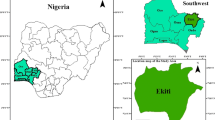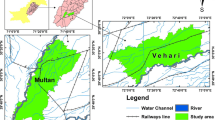Abstract
This paper investigates the impacts of changing land use–land cover on the land surface temperature (LST) and normalized differential vegetation index (NDVI) distribution in the Indian part of the Sundarbans Biosphere Reserve by utilizing remote sensing and geographical information system. Landsat Thematic Mapper (TM), Enhanced Thematic Mapper (ETM+) and Operational Land Imager images of the year 2000, 2010 and 2017, respectively, were used to assess the essential indicators for regional environmental health employing appropriate calibrations and corrections. It was observed that there has been a marked reduction in the areas of plantation, mangrove swamp, mangrove forests and agricultural land since 2000. In contrast, an increase in sand beach, waterlogged areas, mudflat, river, and agriculture area was observed. The mean NDVI values for mangrove forests and plantation have decreased from 0.441 to 0.229 and 0.266 to 0.195, respectively, while river, aquaculture, agricultural and open scrubs classes had higher values. The rate of increase in surface LST was highest over settlements, followed by sand beaches, mudflats, aquaculture, mangrove forest, river, plantations, waterlogged areas and agricultural field. LST showed a negative correlation with NDVI values probably due to the high rate of evapo-transpiration activities of the mangrove vegetations. All these above facts distinctly substantiates that there is an increase in open patches/non-vegetated cover and that the ecosystem is under constant stress.


















Similar content being viewed by others
References
Ahmed, B., Kamruzzaman, M., Zhu, X., Rahman, M. S., & Choi, K. (2013). Simulating land cover changes and their impacts on land surface temperature in Dhaka, Bangladesh. Remote Sensing, 5, 5969–5998. https://doi.org/10.3390/rs5115969.
Bandyopadhyay, J., Mondal, I., & Roy, B. (2014). Change detection of land use and land cover and identification of interrelationship between geomorphology and land use land cover in and around Bakkhali–Fraserganj and Henry Island, South 24 parganas, West Bengal, India. International Journal of Remote Sensing and Geoscience, 3(2), 44–51.
Banerjee, K., Chowdhury, M. R., Sengupta, K., Sett, S., & Mitra, A. (2012). Influence of anthropogenic and natural factors on the mangrove soil of Indian Sundarbans wetland. Archives of Environmental Science, 6, 80–91.
Buyadi, S. N. A., Mohd, W. M. N. W., & Misni, A. (2013). Impact of land use changes on the surface temperature distribution of area surrounding the National Botanic Garden, Shah Alam. Procedia Social Behaviour Science, 101, 516–525.
Chander, G., & Markham, B. L. (2003). Revised Landsat-5 TM radiometric calibration procedures, and postcalibration dynamic ranges. IEEE Transactions on Geoscience and Remote Sensing, 41, 2674–2677.
Cristobal, J., Munoz, J. C. J., Sobrino, J. A., Ninyerola, M., & Pons, X. (2009). Improvements in land surface temperature retrieval from the Landsat series thermal band using water vapour and air temperature. Journal of Geophysical Research, 114, 08–103. https://doi.org/10.1029/2008JD010616.
Dutta, D., Das, P. K., Paul, S., Sharma, J. R., & Dhadwal, V. K. (2014). Spatio-temporal assessment of ecological disturbance and its intensity in the mangrove forest using MODIS derived disturbance index. The International Archives of the Photogrammetry, Remote Sensing and Spatial Information Sciences., XL, 8.
Fahmy, T. Y. A., Fahmy, Y., Mobarak, F., El-Sakhawy, M., & Abou-Zeid, R. E. (2018). Biomass pyrolysis: Past, present, and future. Environment, Development and Sustainability. https://doi.org/10.1007/s10668-0200-5.
Fahmy, Y., Fahmy, T. Y. A., Mobarak, F., El-Sakhawy, M., & Fadl, M. H. (2017). Agricultural residues (wastes) for manufacture of paper, board, and miscellaneous products: Background overview and future prospects. International Journal of ChemTech Research, 10(2), 424–448.
Fahmy, Y., & Ibrahim, H. (1970). Rice straw for paper making. Cellulose Chemistry and Technology, 4(3), 339–348.
Foley, J. A., DeFries, R., Asner, G. P., Barford, C., Bonan, G., Carpenter, S. R., et al. (2005). Global consequences of land use. Science, 309, 570–574.
Ghosh, A., Schmidt, S., Fickert, T., & Nüsser, M. (2015). The Indian Sundarban mangrove forests: History, utilization, conservation strategies and local perception. Diversity, 7, 149–169. https://doi.org/10.3390/d7020149.
Giannini, M. B. (2015). Land surface temperature from landsat 5 TM images: comparison of different methods using airborne thermal data measurements and comparison with MODIS remote sensing estimates. Agricultural and Forest Meteorology, 129(2015), 151–173.
Herold, M., Mayaux, P., Woodcock, C. E., Baccini, A., & Schmullius, C. C. (2008). Some challenges in global land cover mapping: An assessment of agreement and accuracy in existing 1 km datasets. Remote Sensing of Environment, 112(2008), 2538–2556. https://doi.org/10.1016/j.rse.2007.11.013.
Huan, P., Zhihao, Q. S., Xu, B., Zhang, C., Lu, L., & Gao, M. (2007). Impacts of land use/land cover change on the spatial variation of land surface temperature in Urumqi, China. Geoinformatics, Remotely Sensed Data and Information. Proceedings SPIE. https://doi.org/10.1117/12.761312.
Islam, M. S., & Islam, K. S. (2013). Application of thermal infrared remote sensing to explore the relationship between land use–land cover changes and urban heat Island effect: A case study of Khulna City. Journal of Bangladesh Institute of Planners, 6, 49–60.
Jalili, S. Y. (2003). The effect of land use on land surface temperature in the Netherlands. Lund University, GEM Thesis Series nr, 1.
Julien, Y., Sobrino, J. A., Matter, C., Ruesca, A. B., Jimenezmuno, J. C., Soria, G., Hidalgo, V., Atitar, M., Franch, B., & Cuenca, J. (2011). Temporal analysis of normalized difference vegetation index (NDVI) and land surface temperature (LST) parameters to detect changes in the Iberian land cover between 1981 and 2001. International Journal of Remote Sensing, 32(7), 2057–2068. https://doi.org/10.1080/01431161003762363.
Jung, M., Henkel, K., Herold, M., & Churkina, G. (2006). Exploiting synergies of global land cover products for carbon cycle modelling. Remote Sensing of Environment, 101, 534–553.
Kamble, B., Irmak, A., & Hubbard, K. (2013). Estimating crop coefficients using remote sensing-based vegetation Index. Remote Sensing, 2013(5), 1588–1602. https://doi.org/10.3390/rs5041588.
Karnieli, N., Agam, R. T., Pinker, M., Anderson, M. L., Imhoff, G., & Gutman, G. (2010). Use of NDVI and land surface temperature for drought assessment: Merits and limitations. Journal of Climate, 23, 618–633.
Katsiabani, K., Adaktilou, N., & Cartalis, C. (2009). A generalised methodology for estimating land surface temperature for non-urban areas of Greece through the combined use of NOAA–AVHRR data and ancillary information. Advances in Space Research, 43(2009), 930–940. https://doi.org/10.1016/j.asr.2008.09.002.
Kovacs, J. M., Wang, J., & Blanco-Correa, M. (2001). Mapping disturbances in a mangrove forest using multi-date LANDSAT TM imagery. Environmental Management, 27(5), 763–776.
Kumar, K. S., Bhaskar, P. U., & Padmakumari, K. (2012). Estimation of land surface temperature to study urban heat island effect using Landsat ETM+ image. International Journal of Engineering Science Technology, 4(2), 771–778.
Kustas, W., & Anderson, M. (2009). Advances in thermal infrared remote sensing for land surface modelling. Agricultural and Forest Meteorology, 149, 2071–2081.
Lambin, F. E., & Ehrlich, D. (1997). Land-cover changes in Sub-Saharan Africa (1982–1991): Application of a change index based on remotely sensed surface temperature and vegetation indices at a continental scale. Remote Sensing of Environment, 61, 181–200.
Liu, L., & Zhang, Y. (2011). Urban heat Island analysis using the Landsat TM data and ASTER data: A case study in Hong Kong. Remote Sensing, 3, 1535–1552. https://doi.org/10.3390/rs3071535.
Maiti, S. K., & Chowdhuri, A. (2013). Effects of anthropogenic pollution on mangrove biodiversity: A reiew. Journal of Environmental Protection, 4, 1428–1434.
Mallick, J., Kant, Y., & Bharath, B. D. (2008). Estimation of land surface temperature over Delhi using Landsat-7 ETM. Journal of Indian Geophysical Union, 12(3), 131–140.
Marland, G., Roger, A., Pielke, S. R., Apps, M., Avissar, R., Betts, R. A., et al. (2003). The climatic impacts of land surface change and carbon management, and the implications for climate-change mitigation policy. Climate Policy, 3, 149–157.
Mcpherson, E. G., Nowak, D., Heisler, G., Grimmond, S., Souch, C., Grant, R., et al. (2003). Quantifying urban forest structure, function, and value: The Chicago Urban Forest Climate Project. Urban Ecosystems, 1, 49–61.
Misra, A., Murali, M. R., & Vethamony, P. (2015). Assessment of the land use/land cover (LULC) and mangrove changes along the Mandovi–Zuari Estuarine complex of Goa, India. Arabian Journal of Geoscience, 8, 267–279.
Mitra, A., Gangopadhyay, A., Banerjee, K., Dube, A., & Schmidt, A. (2009). Observed changes in water mass properties in the IndianSundarbans (northwestern Bay of Bengal) during 1980–2007. Current Science, 97(10), 1445–1452.
Mondal, I., & Bandyopadhyay, J. (2014). Coastal zone mapping through geospatial technology for resource management of Indian sundarban, West Bengal, India. International Journal of Remote Sensing Applications (IJRSA), 4(2), 103–112. https://doi.org/10.14355/ijrsa.2014.0402.04.
Nagendra, H., Lucas, R., Pradinho, J., Jongman, R. H. G., Tarantino, C., Adamo, M., et al. (2013). Remote sensing for conservation monitoring: Assessing protected areas, habitat extent, habitat condition, species diversity and threats. Ecological Indicators, 33, 45–59.
Omran, E. S. E. (2012). Detection of land-use and surface temperature change at different resolutions. Journal of Geographical Information System, 4, 189–203. https://doi.org/10.4236/jgis.2012.43024.
Qin, Z., Karnieli, A., & Berliner, P. (2001). A mono-window algorithm for retrieving land surface temperature from Landsat TM data and its application to the Israel-Egypt border region. International Journal of Remote Sensing, 22(18), 3719–3746.
Rajeshwari, A., & Mani, N. D. (2014). Estimation of land surface temperature of Dindigul district using landsat 8 data. IJRET: International Journal of Research in Engineering and Technology. https://ijret.org/volumes/2014v03/i05/IJRET20140305025.pdf.
Sahana, M., Ahmed, R., & Sajja, H. (2016). Analyzing land surface temperature distribution in response to land use/land cover change using split window algorithm and spectral radiance model in Sundarban Biosphere Reserve, India. Model Earth System Environment, 2, 81. https://doi.org/10.1007/s40808-016-0135-5.
Thakur, S., Dharanirajan, K., Ghosh, P. B., Das, P., & De, T. K. (2017). Influence of anthropogenic activities on the landuse pattern of South Andaman Islands. Research Journal of Marine Sciences, 5(1), 1–10.
Vicente-Serrano, S. M., Azorin-Molina, C., Sanchez-Lorenzo, A., Revuelto, J., Moran-Tejeda, E., Lopez-Moreno, J. I., et al. (2014). Sensitivity of reference evapotranspiration to changes in meteorological parameters in Spain (1961–2011). Water Resource Research, 50, 8458–8480.
Weng, Q., Liu, H., & Lu, D. (2007). Assessing the effects of land use and land cover patterns on thermal conditions using landscape metrics in city of Indianapolis, United States. Urban Ecosystem, 10, 203–219.
Weng, Q., Lu, D., & Schubring, J. (2004). Estimation of land surface temperature-vegetation abundance relationship for urban heat island studies. Remote Sensing of Environment, 89, 467–483.
Yue, W., Xu, J., Tan, W., & Xu, L. (2007). The relationship between land surface temperature and NDVI with remote sensing: Application to Shanghai LANDSAT 7 ETM+ data. International Journal of Remote Sensing, 28(15), 3205–3226.
Zhang, Q., Xu, C. Y., Becker, S., Zhang, Z. X., Chen, Y. D., & Coulibaly, M. (2009). Trends and abrupt changes of precipitation maxima in the Pearl River basin, China. Atmospheric Science Letters, 10, 132–144.
Zhou, X., & Wang, Y. C. (2010). Dynamics of land surface temperature in response to land-use/cover change. Geographical Research, 49(1), 23–36. https://doi.org/10.1111/j.1745-5871.2010.00686.x.
Acknowledgements
This work was supported by the Department of Science and Technology (DST), INSPIRE Division, Government of India, for the award of DST INSPIRE Fellowship (IF140969)] to Mr. Sandeep Thakur and he is grateful for it.
Author information
Authors and Affiliations
Corresponding author
Ethics declarations
Conflict of interest
On behalf of all authors, the corresponding author states that there is no conflict of interest.
Additional information
Publisher's Note
Springer Nature remains neutral with regard to jurisdictional claims in published maps and institutional affiliations.
Rights and permissions
About this article
Cite this article
Thakur, S., Maity, D., Mondal, I. et al. Assessment of changes in land use, land cover, and land surface temperature in the mangrove forest of Sundarbans, northeast coast of India. Environ Dev Sustain 23, 1917–1943 (2021). https://doi.org/10.1007/s10668-020-00656-7
Received:
Accepted:
Published:
Issue Date:
DOI: https://doi.org/10.1007/s10668-020-00656-7




